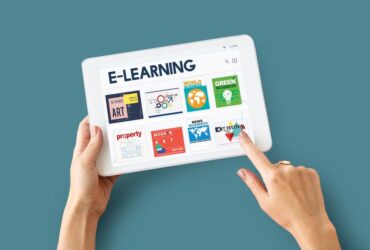Computer Based Training (CBT) is a type of education where students learn through computer-based programs. These programs often include interactive instructional software tailored to specific learning objectives.
With the advent of digital technology, Computer Based Training has become a staple in both corporate and educational settings. This method leverages multimedia elements like text, audio, images, and video to enhance the learning experience. CBT is particularly advantageous for its flexibility, as it allows learners to progress at their own pace and on their own schedules.
Users can engage with material from anywhere as long as they have a computer or a compatible device, making it an excellent tool for remote education and decentralized training programs. Its self-guided nature helps in catering to diverse learning styles and paces, thus ensuring a more personalized education approach. The integration of quizzes and interactive assessments further ensures the monitoring of a student’s progress and understanding, aligning with modern educational needs and expectations.

Credit: unitar.org
The Evolution Of Digital Learning
The Evolution of Digital Learning traces how technology transforms education.
Unlike traditional classrooms, computer-based training offers interactive and tailored learning experiences.
From Chalkboards To Keyboards
Education began with simple tools. Today, it thrives on innovation and digital platforms.
Keyboards replaced chalkboards to deliver content globally.
- Interactive whiteboards augment lesson engagement.
- Tablets and smartphones allow for learning on-the-go.
- Virtual classrooms connect learners from diverse locations.
E-learning Milestones
| Year | Milestone | Impact |
|---|---|---|
| 1960s | PLATO System | First computer-based learning system |
| 1980s | CD-ROMs | Storage for multimedia learning materials |
| 2000s | LMS Development | Online platforms for course management |
| 2010s | Mobile Learning | Access courses on mobile devices |
Defining Computer-Based Training
Computer Based Training (CBT) is an innovative way to learn new skills through a computer or mobile device. Unlike traditional classrooms, CBT lets students learn at their own pace, time, and place. This approach harnesses the power of technology to present information in various interactive formats.
CBT combines multimedia such as text, images, videos, and interactive elements. It provides learners with a flexible and engaging education experience. This form of training is ideal for both academic subjects and workplace learning.
Components Of Computer Based Learning
Let’s explore the key players in the CBT environment:
- Multimedia Content: It blends text, audio, images, animation, and video to engage users.
- Interactivity: Quizzes and scenarios allow users to apply what they learn.
- Learning Management Systems (LMS): Platforms like these track progress and manage content.
- Self-Paced Learning Modules: Users go through these at a speed that suits their needs.
- Immediate Feedback: Users receive instant responses to their actions and decisions.
CBT vs. Traditional Education
Cbt Vs. Traditional Education
The differences between CBT and traditional education are clear:
| Aspect | Computer Based Training | Traditional Education |
|---|---|---|
| Flexibility | Learn any time, anywhere | Fixed schedule and location |
| Pace | At the learner’s own pace | Set by the teacher/class |
| Personalization | Adapts to the user’s learning style | One size fits all approach |
| Scalability | Easy to reach a large audience | Limited by classroom size |
How Computer Based Training Works
Imagine a classroom that fits into your computer. That is Computer Based Training (CBT). It is a way of learning where you use a computer. Instead of a teacher, you have programs that teach you. They can include videos, quizzes, and games. You can learn at your own pace and when you want. It’s like having a personal tutor in your machine!
Interactive Elements In CBT
Interaction keeps learning alive in CBT. Think of it as a conversation between you and the computer. Here’s how:
- Animations bring concepts to life.
- Simulations let you practice real-world skills.
- Games make learning fun and engaging.
You click, drag, and type to learn. Your computer responds with instant feedback. It’s learning by doing!
Role Of Assessments In CBT
Let’s talk about checks and balances in CBT—assessments. They make sure you’re on track. Here’s how they help:
| Assessment Type | Purpose |
|---|---|
| Quizzes | Test your knowledge on-the-go. |
| Mid-Module Tests | Review what you’ve learned so far. |
| Final Exams | See if you’re ready to apply what you learned. |
Assessments in CBT are there to give you feedback, promote practice, and make you think. They are not scary—they are your stepping stones to mastering a subject!

Credit: time.ly
Advantages Of Computer Based Training
Advantages of Computer Based Training (CBT) are reshaping the way individuals learn and grow. Its impact has made learning not just interactive but also flexible and accessible for everyone. Let’s dive into some of its key benefits.
Self-paced Learning Benefits
One of the standout advantages of CBT is Self-Paced Learning. This means learners can go through course material at a speed they are comfortable with. Let’s break down why this is a game-changer:
- Learners control their progress, which reduces stress and increases satisfaction.
- Individuals can review sections as needed, ensuring they understand every topic.
- Flexible schedules allow for balancing learning with work or personal life.
Cost-effectiveness Of Digital Resources
CBT stands out for its cost-saving potentials. Below, find key points on how CBT keeps budgets in check:
| Cost-Saving Aspect | Description |
|---|---|
| No Physical Materials | Digital resources eliminate the need for expensive textbooks and handouts. |
| Less Travel | Learners save on commuting as they can study from anywhere with a computer. |
| No Classroom Costs | Organizations save on physical space as learning happens online. |
By integrating both self-paced learning and digital cost savings, Computer Based Training sets itself as an advantageous approach for students and organizations alike.
Challenges And Limitations
Computer Based Training (CBT) brings many benefits. But users face challenges too. Knowing these helps improve learning.
Addressing Technical Difficulties
Certain technical issues can disrupt CBT. Users may feel frustrated when they occur.
- Internet problems: A steady connection is vital for seamless learning.
- Software glitches: Programs must work well. Otherwise, learners can’t proceed.
- Hardware failures: Devices should function properly for a smooth experience.
Support teams should fix these issues fast. Simplified troubleshooting guides also help learners.
Navigating The Lack Of Human Touch
CBT often lacks a personal touch. Learning alone might be tough for some. Others might miss class interactions.
| Challenge | Impact |
|---|---|
| Isolation | Can reduce motivation. |
| Feedback | Immediate, human feedback is rare. |
| Adaptation | Content does not always adapt to user needs. |
Instructors can host live sessions to add human elements to CBT. Forums and chats can also encourage interaction.

Credit: www.linkedin.com
Implementing CBT In Various Industries
Implementing Computer Based Training (CBT) in various industries has revolutionized how organizations approach upskilling employees and educating students. With digital tools, industries tailor learning experiences to their unique needs. This personalization enhances knowledge retention and efficiency. Let’s explore CBT’s impact on corporate training and academic education.
Corporate Training Transformation
Corporations worldwide are rapidly shifting to CBT for staff training. It’s economical, scalable, and flexible. Here are key benefits companies experience when adopting CBT:
| Benefit | Description |
|---|---|
| Cost-Effective | Reduces travel and material costs associated with traditional training. |
| Consistency | Ensures uniform training quality across all departments. |
| Convenience | Learners access material any time, fitting training around their schedules. |
| Customization | Tailors modules to meet specific job requirements and learner styles. |
- It allows tracking of employee progress.
- It offers interactive modules to boost engagement.
Changing The Face Of Academic Education
In schools and universities, CBT creates a dynamic learning environment. Here’s how:
- Interactive Content: Engages students with quizzes and games.
- Accessibility: Makes learning materials available 24/7.
- Personalized Learning: Adapts to each student’s pace.
Results? Better performance and a deeper understanding of subjects. Education institutions use CBT to supplement traditional teaching, offering students a blend of both worlds.
Revolutionizing Personal Development
The sphere of personal development is undergoing a transformative shift with the emergence of Computer Based Training (CBT). This advanced mode of learning equips individuals with the tools to enhance their skills and knowledge at their own pace. CBT serves as a revolutionary approach to personal growth, adapting to the unique needs and learning styles of each user.
Lifelong Learning Through CBT
Computer Based Training paves the way for continuous education, breaking the barriers of traditional learning environments. With CBT, learners access resources and material online, anytime and anywhere. This flexibility means personal development never has to pause, fueling a culture of lifelong learning.
- Convenience: Learn at your own time and pace.
- Accessibility: Courses available to anyone with a computer.
- Variety: Diverse topics to explore and master.
Customized Learning Experiences
CBT stands out with its ability to offer tailored learning paths. Interactive modules assess individual progress and adapt accordingly. Users revel in a learning experience that acknowledges their strengths and areas for improvement.
| Features of CBT | Benefits |
|---|---|
| Adaptive Lessons | Matches learner’s pace and level. |
| Interactive Content | Engages and retains learner’s interest. |
| Immediate Feedback | Enables real-time improvement. |
With diverse multimedia elements such as videos, quizzes, and simulations, CBT transforms the learning experience into an engaging journey. This personalized approach keeps learners motivated, aiding in the effective development of their personal and professional competencies.
The Future Of Computer Based Training
The Future of Computer Based Training hints at an educational revolution. Traditional learning methods evolve to embrace technology fully. This progression promises tailored, accessible, and interactive learning experiences.
Emerging Technologies In CBT
Computer Based Training (CBT) is constantly enhanced by innovations. Users witness immersive learning through virtual reality (VR) and augmented reality (AR). AI-driven personalization caters to individual learning paces and styles.
- Artificial Intelligence: Smart algorithms adapt course content in real-time.
- Machine Learning: Systems learn from user interactions to improve engagement.
- Virtual Classrooms: Geographical barriers disappear as students join from anywhere.
- Blockchain Technology: Secures user data and verifies educational credentials transparently.
Predictions For The Next Decade
CBT will likely become more immersive and user-friendly. Expect broader access, with mobile-first strategies leading the way. Personalized learning plans will become the norm. Here’s a glance at what the next decade might introduce:
| Year | Technology | Impact |
|---|---|---|
| 2024 | AI-enhanced CBT | Customizable learning experiences skyrocket. |
| 2026 | 5G Network | CBT becomes faster and more efficient. |
| 2028 | Neuro-interactive Platforms | Learners train using brain-computer interfaces. |
These advancements suggest a future where learning is limitless. CBT’s ability to adapt quickly to technological changes places it at the forefront of education.
Frequently Asked Questions On What Is Computer-Based Training
What Is Computer-Based Training (CBT)?
Computer Based Training, or CBT, is a type of education in which students learn through computer-based programs. These programs often include interactive lessons, multimedia content, and assessments. CBT allows for self-paced learning and can be accessed remotely.
How Is CBT Different From Traditional Learning?
Unlike traditional classroom learning, CBT is delivered through computer applications, allowing flexible pacing and access. It focuses more on interactive, visual, and auditory learning techniques. CBT often eliminates the need for a physical classroom setting.
What Are The Advantages Of Computer-Based Training?
Advantages of CBT include its accessibility, cost-effectiveness, and flexibility. It allows for personalized learning paths and immediate feedback. CBT can be scaled easily to educate large numbers of learners.
Can CBT Cater To Different Learning Styles?
Yes, CBT can cater to various learning styles with its range of interactive and multimedia content. It can adapt to visual, auditory, and kinesthetic learners by employing diverse teaching methods within the programs.
Conclusion
Computer Based Training (CBT) revolutionizes how we learn and work. By embracing interactive, on-demand learning, we enhance our skill sets efficiently. Let’s empower ourselves: dive into the digital learning era with CBT. It’s your move to stay ahead in a fast-paced professional landscape.
Embrace the change, reap the benefits.












































Leave a Reply